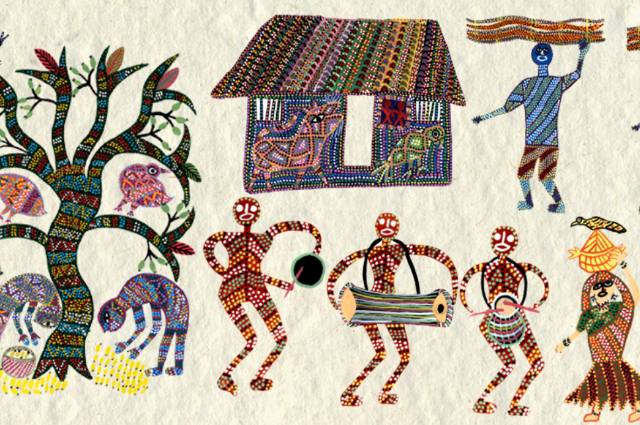The heart of India, Madhya Pradesh, is often recognized for its dense forests, delicious poha, rapidly growing cities, and diverse wildlife. Such things define our state to anyone who isn't quite familiar, but, within this very heart lies a quiet yet radiant flame, a gentle spark that illuminates the cultural landscape. This is the fire of Bhil art, a traditional folk practice passed down through generations of women in the bhil tribe.
For the women in the tribe, every stroke represents their stand in society; it's more than just an artistic imprint; it is a whisper of history, an act of devotion, and a silent rebellion against the oppression they face in the society. Bhil art, is a kind of pithora art. It originates from one of India’s largest indigenous communities, the Bhil tribe.
The art can be described as a unique visual language that uses complex dot work and vibrant colors to depict mythology, folklore, and nature by painted them on walls. it reflects a deep spiritual connection with the land and ancestors. For Bhil women, this art form has been more than just an aesthetic tradition, it has served as a means of storytelling, cultural preservation, and resistance.
Historically, women have played a crucial role in sustaining Bhil art, passing it down through generations while using it to express their identity in a society where their voices were often unheard. Their paintings not only document history and daily life but also symbolize empowerment, offering them a rare space for recognition and self-expression.
Among many women from Madhya Pradesh doing this art style some have redefined their place in society through it, gaining national and international acclaim. Buri Bai, once a daily wage laborer, became one of the first Bhil artists to paint on paper and canvas, eventually receiving the Padma Shri. Similar to Bhuri Bai, Narmada Bai, and Rani Bai, among others, have elevated the status of Bhil art beyond their communities, proving that folk traditions can be both a cultural legacy and a source of independence. Through government initiatives, exhibitions, and collaborations with contemporary artists, these women have not only preserved their ancestral art but have also gained financial stability, transforming their lives and inspiring future generations.
As Bhil art finds its way into urban galleries and digital platforms, its essence remains rooted in the hands of the women who nurture it. Whether on mud walls or modern canvases, it continues to be a testament to their resilience, bridging the past and the future while leaving room for new narratives to emerge.

